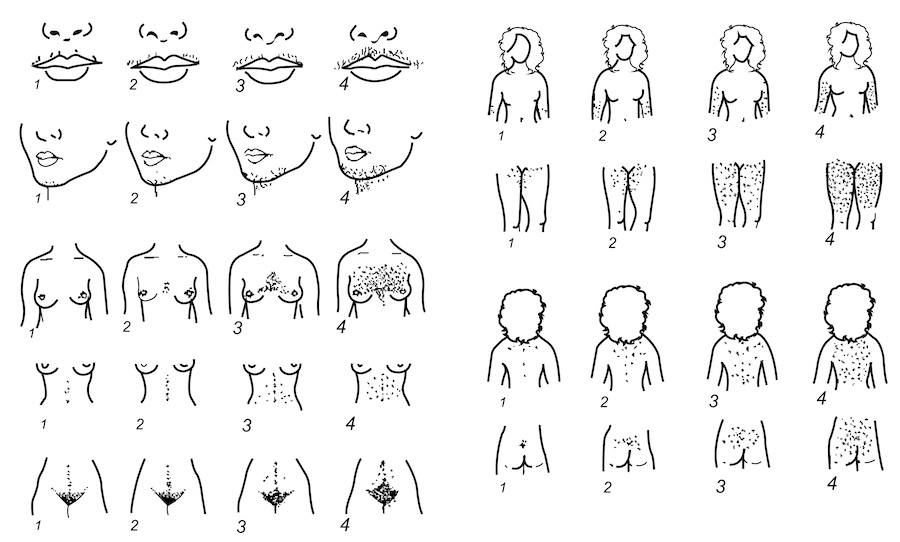The Ferriman-Gallwey Score: How Bad Is My Hirsutism?

The Ferriman-Gallwey Score was originally published by D. Ferriman and J.D. Gallwey in 1961 in the Journal of Clinical Endocrinology and presents health care professionals with a means to evaluate and quantify Hirsutism in women. It is the gold standard for evaluating hirsutism and is routinely used by healthcare professionals all around the globe. In order to determine whether a woman has mild, moderate or severe hirsutism, nine body areas sensitive to male sex hormones (androgens) are assigned a score from 0 to 4 (no hair to virile). The scores are then added together. The result is referred to as the Ferriman-Gallwey Score, which is essentially a Hormonal Hirsutism Score.
👉 Tip: If you would like to know, what your personal Ferriman-Gallwey Score is, scroll to the bottom of this article and take our Hirsutism Quiz.
The Evolution of the Ferriman-Gallwey Score
Since it’s introduction in 1961, the method has seen quite an evolution. The original method assessed 11 body areas. This was eventually decreased to 9 body areas, which are rated from 0 (no growth of terminal hair) to 4 (extensive hair growth). A patient/’s score will therefore be between 0 and 36.
What Body Areas Are Evaluated?
The 11 body areas evaluated according to the original method were upper lip, chin, chest, upper back, lower back, upper abdomen, lower abdomen, upper arms, forearms, thighs and legs. The evaluation of forearms and legs was removed in the modified method.
In 2001 the method was further modified and 10 additional areas were added, bringing the total of locations to 19. Those are:
- Upper lip
- Chin
- Chest
- Upper back
- Lower back
- Upper abdomen
- Lower abdomen
- Upper arms
- Thighs
- Sideburns
- Neck
- Buttocks
- Inguinal area
- Perianal area
- Forearm
- Leg
- Foot
- Toes
- Fingers
The assessment of the different areas on a four-point scale remained unchanged.

Diagnosing Hirsutism: Mild, Moderate or Severe Hirsutism
Generally speaking The Ferriman-Gallwey Score is used to determine whether a patient’s hirsutism is considered mild, moderate or severe. A score of 8 in a Caucasian woman is considered an indicator for excess male hormones and hirsutism. Some experts also argue, that a lower score of 6 is reason enough for further evaluation. During evaluation, a patient’s ethnicity must be considered when interpreting the score.
According to the Clinical Practice Guideline for Hirsutism published by the Endocrine Society in 2018, Ferriman–Gallwey total scores that define hirsutism in women of reproductive age are as follows: United States and United Kingdom black or white women, ≥8; Mediterranean, Hispanic, and Middle Eastern women, ≥9 to 10; South American women, ≥6; and Asian women, a range of ≥2 for Han Chinese women to ≥7 for Southern Chinese women.
Other methods used to diagnose hirsutism include microscopic measurement of hair diameter and counting of shafts, computerized assessment and photographic evaluation. The Ferriman-Gallwey score, however, is still popular in clinics today, as it is a simple, low cost system to decide whether further steps (e.g. blood tests) should be done to further investigate hormone levels and potentially diagnose hirsutism or Polycystic Ovary Syndrome (PCOS).
Hirsutism is usually caused by high levels of testosterone in a women’s system. If a doctor suspects a hormonal imbalance, additional tests will be done to understand the root cause (e.g. PCOS) and help define the right course of action.
Limitations of the Ferriman-Gallwey Score
Although widely used, the Ferriman-Gallwey Scoring System has its limitation. It is subjective in nature and excess hair in other androgen-sensitive areas like the sideburns or forehead, which are not part of the original scoring system, are usually not considered to determine the final score. Many women will also have used cosmetic measures (shaving, waxing, etc.) before a consultation, which makes it difficult to determine an accurate score.
Practitioners also argue, that treatment decisions need to be proportionate to the extent that excessive hair affects the patient’s well-being. A woman with a score of 3 might be more distressed and need more aggressive treatment than another woman with a score of 8 or above, who is not bothered by the symptoms.
